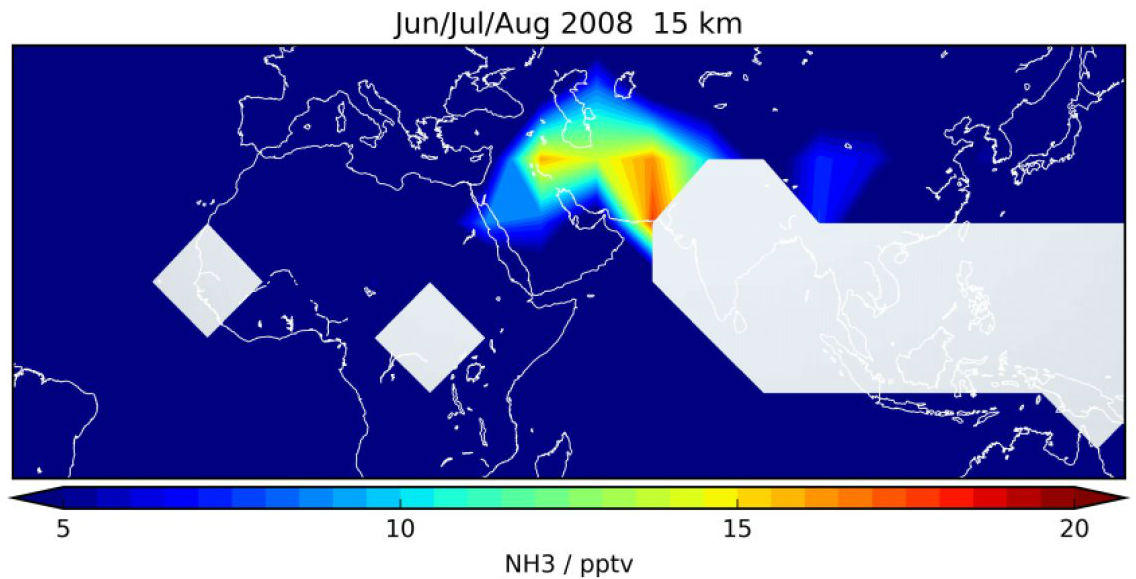For the first time, scientists have detected trace amounts of ammonia in the upper troposphere - the lowest of Earth's atmospheric layers.
Released into the atmosphere as an agricultural emission from livestock farming and fertilisation, ammonia has been found in the highest concentrations above India and China, where population and economic growth has been skyrocketing in recent years.
Earth's troposphere extends from 7 to 20 km (4 to 12 miles) above sea level, and contains up to 80 percent of the planet's atmosphere, and all weather phenomena.
A team from the Karlsruhe Institute of Technology in Germany analysed satellite data collected from various parts of the troposphere between June 2002 to April 2012, and calculated the three-month averages.
They identified atmospheric ammonia - a chemical compound of nitrogen and hydrogen - some 12 to 15 km (7.5 to 9.3 miles) above sea level in the area of the Asian monsoon.
This accumulation of ammonia was found at a concentration of up to 33 pptv (33 ammonia molecules per trillion air molecules) above North India and Southeast China.
Similar levels of ammonia were detected nowhere else on Earth.
"We have presented the first evidence of ammonia being present in Earth's upper troposphere above 6.2 miles (10 km)," the team reports.
"The region and period of detection is confined to the Asian summer monsoon system."
The find reveals that ammonia released on Earth's surface due to agricultural processes survives all the way to the troposphere, where it ends up in monsoons.
"Observations show that ammonia is not washed out completely when air ascends in monsoon circulation," said lead researcher Michael Höpfner.
"Hence, it enters the upper troposphere from the boundary layer close to the ground, where the gas occurs at relatively high concentrations."
 Distribution of the atmospheric ammonia concentration. Credit: Karlsruhe Institute of Technology
Distribution of the atmospheric ammonia concentration. Credit: Karlsruhe Institute of Technology
It's thought that because these traces of ammonia were found in Asian monsoons, the agricultural emission could be playing a role in aerosol formation in the troposphere.
Aerosols - tiny particles made from super-fine solid particles and liquid droplets carried in the atmosphere - often act as 'cloud condensation nuclei', around which cloud droplets are formed.
While they're the smallest particles that are thought to contribute to cloud formation, they also appear to influence the properties of existing clouds.
As NASA explains, aerosols can modify the size of cloud particles, and change how the clouds reflect and absorb sunlight, leading to haze and much redder sunrises and sunsets.
We now know that when ammonia is released as an agricultural emission in high concentrations, it not only pollutes the local ecosystem, it can also drive the formation of new clouds and influence existing clouds in the atmosphere above.
And unfortunately, now that aerosols are building up in our atmosphere, we might actually rely on them to mitigate the effects of global warming.
It's thought that their accumulation in the troposphere could have a cooling effect, compensating in part for the human-caused greenhouse effect.
Ammonia isn't the only unexpected gas scientists have detected in Earth's atmosphere recently - a type of hot atomic hydrogen atom has also been found in an upper layer of Earth's atmosphere - and our current understanding of physics says they shouldn't be able to exist here.
The findings will hopefully give scientists a better basis on which to build their global climate models, and the German team plans to continue modelling the atmospheric ammonia above China and India throughout 2017.
The results have been published in Atmospheric Chemistry and Physics.
